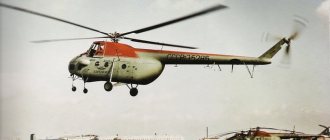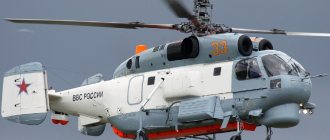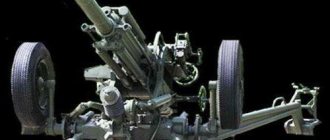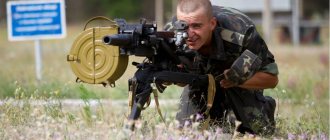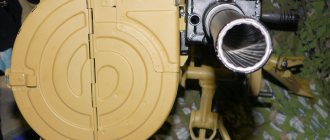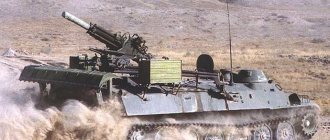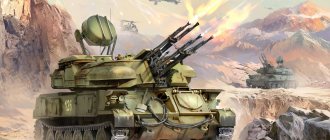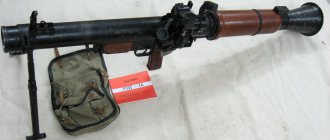Helicopter Ka-8 Irkutsk Speed. Engine. Dimensions. Story. Range of flight
With this small helicopter Ka-8 “Irkutsk” began the creation of machines that have no analogues in the world to this day. By 1945, the creator of the best Soviet gyroplanes N.I. Kamov found himself out of work. Autogyroplanes did not live up to the hopes placed on them, and financing further work on their development began to be considered a waste of money. Nikolai Ilyich was deprived of the design bureau, retaining only a tiny group in which, at the end of the year, real enthusiasts of rotary-wing technology worked - Pavel Serkov and Margarita Lebedeva.
Reliable partner in conjunction
The Ka-226T “Alpinist” is the latest modification of the Ka-226T multi-purpose helicopter, developed in 2008. Thanks to the coaxial design and the innovations introduced, this machine has become an ideal option for high-altitude flights.
Due to the absence of a tail rotor, a coaxial helicopter is more compact and maneuverable, which gives it advantages in mountainous terrain and limited landing capabilities. In addition, the coaxial design provides good controllability at the most extreme altitudes in thin air conditions, resistance to strong crosswinds and a high rate of climb.
Photo: Victor Molodtsov
When rescue operations, loading of the wounded, installation or transport work at high altitudes using an external sling are carried out, precision in actions is important. Therefore, a very valuable quality of the “Alpinist” for working in the mountains is its high hovering accuracy.
In addition, the machine is distinguished by a low level of vibration, ease and simplicity of operation, the ability to take off and land on sites of minimal size, as well as the safety of landing passengers when the propellers are running.
Helicopter Ka-8 Irkutsk - video
This unit was located in one room at plant No. 456 in Khimki. At this time, Kamov was actively engaged in scientific work, wrote his Ph.D. dissertation, the book “Rotor-wing Aircraft,” and advised graduate students of the Moscow Aviation Institute. He couldn’t imagine his life without design creativity and tried to get an order to develop a small helicopter that would not require large expenses. In November 1945, Kamov turned to the expert commission of the People's Commissariat of the Aviation Industry and presented a preliminary design of a single-rotor Ka-12 passenger helicopter with an M-21 engine with a power of 600 hp. But he was refused. Kamov had long been nurturing the idea of another helicopter, which he now decided to try to implement. Understanding full well that both the fate of the machine and his own fate depended on whether the experimental helicopter would find a customer, the designer relied on the fleet. Naval aviation was very interested in aircraft suitable for landing on limited areas - the decks of ships.
Kamov well remembered the interest that aroused his report on testing the KASKR gyroplane, made on September 21, 1931 at the headquarters of the Black Sea Fleet in Sevastopol. The listeners were especially attracted by the possibility of vertical descent of the gyroplane in autorotation mode at zero horizontal speed, which made it possible to land on the deck. Now Kamov decided to take into account as much as possible the possible requirements of the sailors in the project. They probably need a machine with minimal dimensions and high maneuverability - this determined the choice of a coaxial rotor design. The car will fly over the sea - and floats have been used as landing gear. At the beginning of 1946, Kamov and his associates began designing a new device. In February, his group received its first addition - it included MAI graduate Vladimir Barshevsky, who recently successfully defended his graduation project on a coaxial helicopter under the leadership of Kamov. Then several experienced specialists came: T.A. Grishina, V.V. Persiyanov, A.N. Koiarev. The work progressed very quickly. The design of the helicopter was thought out so completely by Kamov that there was no need to rack his brains over the development of any new components. Barshevsky recalled: “Nikolai Ilyich invented it all, entirely, from beginning to end.” All that remained was to make calculations and turn the ideas into full-fledged technical documentation.
On May 3, Order No. 26 was issued by the head of the 7th Main Directorate of the MAP on the subordination of the Kamov group to the TsAGI Bureau of New Equipment. Apparently, the new status made it possible to work on the machine in more favorable conditions. On November 13, MAP order No. 721 was issued, according to which Kamov was entrusted with the official task of creating a helicopter. For this purpose, appropriate funds were allocated; at the same plant 456, two additional rooms were provided, and the team began to be replenished with new specialists. Among them were Candidate of Technical Sciences P.O. Yurchenko. engineer and freshly minted MAI graduates, students of V.I. Kamov. Ivanov and AM Konradov. However, Kamov still did not have any production capacity to manufacture a prototype of the helicopter. Therefore, the construction of the machine had to be carried out in “left” ways, using the money allocated for the task. For example, parts that required processing on metal-cutting machines were ordered at the pilot production of the Tupolev Design Bureau, and rotor blades were ordered at a specialized plant near the platform of the Novaya Kazan Railway. In this matter, Kamov was helped by extensive acquaintances, including among workers, who sometimes made his orders secretly from their bosses, and then illegally carried the finished products through the checkpoints.
By the fall of 1947, almost all components were ready. For the final assembly of the helicopter, Kamov managed to get a corner in a dilapidated workshop at the 456th plant. The helicopter that was built was a welded frame on which an M-76 air-cooled motorcycle engine, a gearbox, a gas tank, a rotor column were placed, and behind it was a pilot’s seat with controls, the characteristic feature of which was a motorcycle-type steering wheel, on the right handle of which the gas sector was located. A small plexiglass fairing was installed in front. Instead of a tail boom, a lightweight triangular pyramid of pipes was used, to the top of which a trapezoidal keel was attached. Both three-bladed rotors were made of laminated, reinforced wood. There was no rotor brake, there was also no radio station and even a pilot's parachute. The role of the chassis was performed by two cone-shaped inflatable cylinders made of rubberized fabric. The strength of the structure had to be tested by its own weight, for which several people climbed onto the frame and jumped on it.
The helicopter was named Ka-8 “Irkutsk”. The birth of this name does not pose a mystery. Ka-8 is an ordinal index of projects developed by Kamov. The name “Irkutsk” was given in honor of the creator of the machine. The point is that Nikolai Ilyich was born in Irkutsk on September 14, 1902. In addition, the helicopter was given the nickname “air motorcycle”, which was very suitable for this tiny device. A small area was allocated for testing the helicopter at the factory airfield. It became a flight test station, the head of which was appointed V.A. Karpov, who was familiar with Kamov technology from the pre-war years from flying the A-7 gyroplane. As a test pilot N.I. Kamov invited his old friend, sub M.D. Gurov, who had already gained experience in helicopter flights by testing I.P. Bratukhin.
Before the Ka-8 took off for the first time, it went through a rather lengthy development phase. Already at the first spin of the screws, significant shaking was revealed. According to Barshevsky’s memoirs, to eliminate it, “first of all, they decided to bring the blades together “in a cone.” This was done right in the assembly room using a pole with a sheet of Whatman paper rolled into a tube attached to it. The blades, marked with different pencils, left their marks on the paper, after which their installation angles were adjusted. As a result, the vibrations decreased slightly, but at high speeds they still increased sharply. Nikolai Ilyich suggested that this was due to the insufficient rigidity of the blade control leads, which had an unsuccessful design. The modification of the leads was carried out very quickly, and the sharp increase in vibrations at high speeds disappeared. Much later, on the Mi-4, and then on the Ka-15, they found out the nature of this phenomenon - it was blade flutter. It had to be “treated” by increasing the rigidity of the control wiring (which Kamov did) or by installing counterweights on the blades.” In addition, when the Ka-8 was first launched, it fell back heavily, although it remained afloat. I had to redo the floats, reducing their taper.
The next obstacle that did not allow the Irkutsk Aircraft into the sky was the insufficient power of the 38-horsepower engine. They tried to lighten the already spartan design of the helicopter as much as possible by removing everything possible, including the tail unit. However, neither this nor the ingenuity of mechanic P.V. Ananyev, who tried to squeeze additional strength out of the engine, did not produce results. And yet, Gurov tore the car off the ground, but at the same time he himself remained on it and stood next to the helicopter that had risen on a leash. Then “spirtzine” was poured into the tank, as the mechanics dubbed the alcohol-gasoline mixture (0.9 for alcohol, 0.1 for gasoline). This made it possible to increase the power by 10-15%, and finally begin tethered tests. Things got off the ground, and Gurov enthusiastically began working on his piloting techniques.
The helicopter behaved quite decently, which prompted Kamov to increase the hover altitude. To do this, they quickly lengthened the leash and changed the mooring locations. However, when the Ka-8 rose about one and a half meters, it shifted to the side, the cables became tense, and the helicopter overturned. Gurov was not injured, but one of the flying fragments of the blade hit Kamov, who was standing nearby, quite hard on the shoulder. During the repair, new blades with a different profile were installed on the machine, and the base of the floats was slightly increased. Obviously, at the same time the straight upper tail mounting tube was replaced with a curved one. When the Ka-8 was ready to continue testing, cold weather set in, which had a positive effect on the flight performance of the Irkutsk.
They decided to free the helicopter, and on November 12, 1947, Gurov performed his first free flight in a circle. The Ka-8 flew more and more confidently, but one day, when the car was at an altitude of about 200 m, the engine overheated and stalled. “It was clearly visible from the ground,” Barshevsky recalled, “how, in the ensuing silence, Gurov put the helicopter into gliding mode, and then tried to “blow up” it in the air with a common step and handle, as if simulating a landing. The car obediently scraped. The pilot again switched it to gliding and, repeating the leveling maneuver, landed the helicopter in deep snow. The cylinders slid across the snow, then buried themselves in it, and the helicopter smoothly tipped forward. Gurov got out of the chair alive and well.” In this unexpected way, practical evidence was obtained that a coaxial helicopter can autorotate perfectly, and this made it possible to clearly show how wrong the opponents of the Ka-8 were, who authoritatively stated: “The coaxial configuration does not autorotate!” In his autobiography N.I. Kamov wrote: “By designing the Ka-8, we for the first time solved the problem of creating a workable coaxial load-bearing system. The all-wood main rotor blades, controls, and general and differential pitch mechanisms that we designed were original. These designs formed the basis for all our subsequent activities in the field of coaxial helicopter construction.”
By the summer of 1948, the money allocated for the creation of the Ka-8 had run out, and the Ministry of Aviation Industry was not going to continue supporting the unpopular topic. Kamov’s employees were no longer paid, and there was no money even to buy “spiritzin.” The situation was saved by the inclusion of “Irkutsk” in the program of the traditional air parade in Tushino, under which Kamov ordered the continuation of work for a month and a half. Shortly before the parade, the Ka-8 was shown to the commander of the Moscow Military District, Vasily Stalin. Gurov performed a short demo flight. which did not leave the general and experienced pilot indifferent: “Great! Get ready for the parade." In an effort to most effectively show the car to potential customers, Nikolai Ilyich proposed using a platform mounted on the back of a truck as an airfield. Vasily Stalin liked this circus trick, and it was included in the parade plan. The day before the air festival, Kamov was summoned to see Air Chief Marshal K.A. Vershinin to clarify the program of the speech and the accompanying announcer's text. During the discussion, Kamov proposed using the term “helicopter”, which he had invented, which, in his opinion, was more suitable for naming devices with a main rotor than the English-language term “helicopter” then used. The proposal was met very approvingly, “helicopter” was included in the announcer’s text, and soon this easily pronounced word grew into our speech.
On July 25, 1948, the best aircraft of the Land of Soviets fly over the airfield of the Tushinsky airfield. People are enthusiastically watching the demonstration of the power of the Air Force. Suddenly, a well-deserved ZiS-5 truck drives up to the government podium. In its back, some strange device rumbles with its engine. In front of the podium, the truck slows down. The device, its engine roaring, takes off into the sky. It was a Ka-8 helicopter.
In general, the Ka-8 show made the most favorable impression not only on ordinary spectators, but also on the country's leaders. Stalin himself conveyed his congratulations to Kamov and, right during the parade, ordered the Minister of Aviation Industry to provide the designer with every opportunity to fully continue his work. The helicopter was requested the very next day to the Naval Air Force Research Institute. Since one copy of the “Irkutsk” was not enough to conduct comprehensive tests, an urgent order was received to produce two more similar vehicles. The simplicity of the Ka-8 design allowed the order to be completed immediately. Institute tests did not last long and showed that in its original form the Ka-8 was not suitable for use in the navy. Due to the conical floats, the helicopter’s seaworthiness was simply non-existent - at the slightest wave it fell backwards. By using cylindrical floats, this drawback was eliminated. The situation with the power plant was worse. The engine power was clearly low. Moreover, the motorcycle engine itself with its “spirtzine” was not suitable for a military aircraft. Despite this result, the main goal was achieved. By the decision of the Council of Ministers of the USSR on September 29, 1948, OKB-2 was recreated, headed by N.I. Kamov and received an order to develop a new version of a coaxial helicopter.
The beginning of the way
As a student at the Tomsk Technological Institute, young Nikolai Kamov saw an airplane in action for the first time and finally became “sick” of aeronautics. He was not accepted into the Red Army air squad because of a congenital defect of his right hand. Therefore, the student began to collect all possible information on the aviation topic. At the institute, his desk neighbor was the outstanding pilot, aviation pioneer, Khariton Slavorossov, already famous for his records, who, of course, also fueled Kamov’s interest in the aviation topic.
Nikolai Ilyich’s father was a literature teacher from a merchant family, and his mother was a midwife of Polish origin. Interesting fact: the childhood of the two founders of the Soviet helicopter industry, Kamov and Mil, was spent literally in neighboring courtyards of Irkutsk, with a difference of several years. As a child, Kolya Kamov was interested in medicine and chemistry, but after graduating from college he firmly decided to become an engineer. The institute's aviation circle helped him expand his theoretical knowledge of aerodynamics, and starting from his third year, Kamov himself purposefully studied aircraft engineering. It should be noted that Nikolai became the youngest graduate in the history of the Tomsk Institute of Technology.
After graduating from university, Kamov did not give up on his dream of creating airplanes and became a mechanical engineer at the Moscow Junkers concession plant. Over the course of three years, he goes through all the stages of aircraft production, and in the evenings he studies works on aerodynamics. Afterwards, Kamov goes to work in the Dobrolet workshops, where he repairs the same Junkers as an engineer. Thanks to Kamov, Dobrolet is starting to independently produce aircraft parts instead of expensive German ones. The young engineer not only repairs German cars, but also improves their design to reduce mileage.
Performance characteristics of the Ka-8 Irkutyanin
— First flight: November 12, 1947 — Total built: 3
Crew of Ka-8 Irkutsk
- 1 person
Overall dimensions of Ka-8 Irkutsk
— Rotor diameter: 5.6 m — Fuselage length: 3.7 m — Height: 2.5 m
Ves Ka-8 Irkutsk
— Normal take-off: 320 kg
Engine Ka-8 Irkutsk
— Quantity, type, brand: 1 × PD, M-75 — Power: 1 × 38 l. s., boosted 1 x 42 hp
Speed Ka-8 Irkutsk
— Maximum speed: 80 km/h
Static ceiling of Ka-8 Irkutsk
— 50 m
Dynamic ceiling Ka-8 Irkutsk
— 250 m
Description
Unlike other Kamov machines, the Ka-62 has an aerodynamic design with one four-bladed main rotor and a twelve-bladed tail rotor placed in an annular channel on the tail of the helicopter. Placing the tail rotor in this way significantly increases the efficiency of its use and increases the efficiency of the power plant.
ka-62 - diagram
The integrated circuit of the fuselage with contours that reduce drag also saves fuel, and composite materials, which make up 60% of the body, play a big role in this, which significantly improves the weight characteristics of the helicopter.
A recently signed contract with the French company Turbomeca allows the Ka-62 to be equipped with highly efficient Ardiden 3G engines with FADEC digital equipment, which reduces pilots’ almost all workload of monitoring engine operation. In addition to FADEC, the crew is helped to monitor the air situation by GPS and GLONASS systems (compatible with the European Galileo), which are part of the on-board navigation system.
The fuselage structure is divided into the following compartments: the pilot's cabin, the passenger and cargo compartment, the tail section and the tail boom. The glass cockpit is protected by organic bird-resistant triplex and has two workstations, and the commander can be placed either in the left or right seat; the avionics layout allows control from any place.
The cargo-passenger compartment can accommodate up to 14 seats; passengers board and disembark through wide side doors on both sides, which slide towards the tail unit. The total load of the Ka-62 is 2.7 tons of cargo, which can be placed inside the cargo-passenger cabin, as well as on an external sling.
passenger compartment
Optimal payload capacity and a spacious passenger cabin make it possible to use the helicopter for aerial surveillance and search purposes, successfully conduct rescue operations, use the machine as an “air crane”, etc.
The small carrying capacity of the Ka-62 was not chosen by chance; studies showed that the Mi-8 could take 4 tons of cargo, and 80% carried out transportation with a load of no more than 2.1 tons, and this had a negative impact on the economic operation of the helicopter.
The vehicle was equipped with a modern chassis; the development of such a unit was carried out on the principle of combined units, which greatly facilitates their further maintenance. The Ka-62 chassis allows it to withstand landing at high vertical speed and provides the ability to fly from the ship's deck.
Photo Ka-8 Irkutsk
Similar
Mi-28N Night Hunter Armament. Speed. Engine. Dimensions. Story
Helicopter Mi-24 Speed. Engine. Dimensions. Story. Range of flight
Helicopter Mi-8 Engines. Dimensions. Weight. Story. Range of flight
Ka-52 Alligator Armament. Speed. Engine. Dimensions. Story
Helicopter Mi-26 Engines. Dimensions. Load capacity. Story. Range of flight
Helicopter CH-47 Chinook Speed. Engine. Dimensions. Story. Range of flight
Helicopter AH-64 Apache Speed. Engine. Dimensions. Story. Range of flight
Ka-50 Black Shark Armament. Speed. Engine. Dimensions. Story
Helicopter Mi-6 Load capacity. Engine. Dimensions. Story. Range of flight
Helicopter Mi-2 Speed. Engine. Dimensions. Story. Range of flight
Helicopter Bell UH-1 Iroquois Armament. Speed. Dimensions. Engine
Helicopter Mi-12 Engines. Dimensions. Weight. Story. Load capacity
Helicopter Mi-4 Engine. Dimensions. Weight. Story. Range of flight
Helicopter Ka-27 Speed. Engine. Dimensions. Story. Range of flight
Helicopter Ka-226 Engines. Dimensions. Story. Weight. Range of flight
Helicopter Ka-26 Engine. Dimensions. Weight. Story. Range of flight
Helicopter Ka-62 Engine. Dimensions. Weight. Story. Range of flight
Helicopter Mi-14 Speed. Engine. Dimensions. Story. Range of flight
Helicopter Yak-24 Engines. Dimensions. Weight. Story. Load capacity
Helicopter Mi-1 Engine. Dimensions. Weight. Story. Range of flight
Helicopter Mi-38 Engine. Dimensions. Weight. Story. Range of flight
Helicopter Mi-10 Engines. Dimensions. Weight. Story. Load capacity
Helicopter Mi-34 Engines. Dimensions. Weight. Story. Range of flight
Helicopter Ka-29 Speed. Engine. Dimensions. Story. Range of flight
Helicopter B-7 Speed. Engine. Dimensions. Story. Range of flight
Helicopter Ka-60 Killer whale Speed. Engine. Dimensions. Story. Range of flight
Helicopter AH-1 Cobra Speed. Engine. Dimensions. Story. Range of flight
Helicopter Ka-25 Speed. Engine. Dimensions. Story. Range of flight
Helicopter Ka-10 Engine. Dimensions. Story. Weight. Range of flight
Helicopter Ka-8 Irkutsk Speed. Engine. Dimensions. Story. Range of flight
Helicopter Ka-118 Engine. Dimensions. Story. Load capacity
Helicopter Ka-22 Engines. Dimensions. Weight. Story. Range of flight
Helicopter Ka-18 Engine. Dimensions. Story. Weight. Range of flight
Helicopter Ka-126 Engine. Dimensions. Story. Load capacity
Helicopter Ka-15 Engine. Dimensions. Story. Range of flight. Static ceiling
Helicopter Ka-31 Engine. Dimensions. Story. Range of flight. Static ceiling
Helicopter Ka-37 Engine. Dimensions. Story. Range of flight
History of creation
The promising Russian Ka-62 helicopter is positioned as a civilian version of the Ka-60 military vehicle in the 6.5 ton class. Work on this project began in a difficult time for Russia - in the 90s. The civilian modification retained all the design features of the military model, right down to the power plant of two RD-600 engines.
After the demonstration of a life-size model of a helicopter at MAKS-1995, further development of the project ceased due to the difficult financial situation in the country. Only a decade and a half after the start of development, the new machine design in mock-up form was shown at the HeliRussia 2012 aviation exhibition.
Turbomeca Ardiden 3G
The main layout of the helicopter remained unaffected; changes were made to the design of the chassis and power plant compartment, where French Turbomeca Ardiden 3G engines with a transmission from Austria from Zoerkler were installed instead of the domestic RD-600. Tests in 2013 showed the need for improvements to the model; a military modification of the helicopter was supposed to undergo test flights in 2014.
The civilian version of the vehicle made its first installation flight on April 28, 2016. In the evening of that day, the helicopter took off from the ground and was tested in hover mode with changes in the flight profile in heading and pitch, after which it landed safely and taxied to the parking lot. The construction of new Ka-62 vehicles will be launched at the Progress holding company, where the structure itself is assembled and the engines are installed, and the main and tail rotors are produced at KumAPP OJSC.
Orders
On August 31, 2011, a contract was signed between Oboronprom and Oboronprom for the production and supply of 140 units of Ka-52 helicopters, with a total value of 120 billion rubles. until 2022. The contract does not specify which modifications of the helicopters will be produced for the Russian Ministry of Defense.
04/08/2014 The Ministry of Defense of the Russian Federation signed a contract for the purchase of 32 deck-based Ka-52 helicopters. They were planned to be installed on two Mistral helicopter carrier ships, which were pre-ordered in France for Russia. In connection with the events of the last year, the worsening of relations between the Russian Federation and France may interfere with the implementation of agreements.
Based on the words of Russian Deputy Defense Minister Yuri Borisov, by 2022 there is an order for the supply of 146 Ka-52 Alligator attack helicopters, 32 of which are deck-based versions.
Perspective
The Ka-62 was developed at the production facilities of Kamov OJSC, the design bureau and holding company Russian Helicopters. This is the first civil helicopter in the manufacturer’s line, made using a single-rotor design. The tail rotor is enclosed in an annular channel having a vertical tail.
Over 3 billion rubles were spent on the development of the machine over more than 20 years. The amount is quite decent, so the market value of the helicopter will not be low either: presumably about $10 million. It is known that the release of the new product will be largely focused on the international market.
Arsenyevskaya Aviation will be responsible for serial production of the KA-62 model. The military version is expected a year after the launch of full production. Due to its high technology and widespread use of innovative solutions, the KA-62 helicopter will be certified only in 2022. In the meantime, further tests and tests await this model, which will improve the quality and reliability of the aircraft, eliminating possible risks and creating a truly legendary and unique helicopter in the entire global aircraft industry.
Design
The power plant includes 2 Al-34 engines, produced by NPO Lyulka-Saturn (Rybinsk). Each engine has a power of about 1000 hp. The helicopter can also be equipped with Canadian engines from Pratt-Whitney or turboprop TV-0-100.
The layout of the Mi-54 helicopter is created according to the classic single-rotor design, which has a four-bladed main rotor with a diameter of 13.5 m and a four-bladed tail rotor with a diameter of 2.6 m. The forward part of the fuselage is occupied by a double cockpit with a side door and an equipment compartment. Closer to the center of the fuselage is a cargo compartment that can accommodate up to 12 people. On the sides of the cabin there are large cargo hatches, which are closed with sliding doors; fuel tanks are located in the floor. Behind the cargo compartment, towards the tail, there is another fuel tank, an equipment compartment, and behind it is a luggage compartment.
The technical features of the Mi-54 include:
- wide doors with cargo doors, which create convenience in loading and unloading operations and transportation of long cargo;
- combination of classical alloys and composite materials in the construction material;
- perfect aerodynamic configuration of the steering and main rotors;
- screw bushings do not require lubrication;
- the presence of a noise-absorbing system;
- tightness of the fuel system during an emergency landing;
- the presence of additional energy-absorbing chambers in the landing gear;
- additional cushioning for pilot and passenger seats;
- air conditioning system.
The fuselage material is made mainly of traditional aluminum alloys. Composite materials are used in the structures of helicopter non-power elements. The Mi-54 landing gear is non-retractable, tricycle, supported by the front strut. The propeller blades are made of fiberglass. The main rotor hub is made of titanium and is surrounded by elastomeric bearings. In general, low peripheral speed at the ends of the screws ensures low noise levels. The Mi-54 has a hydromechanical control system.
The base model must be equipped with the following equipment systems:
- dust protection devices for engines;
- anti-icing system;
- cabin heating system;
- dual control system;
- flight navigation system for flights in low visibility conditions;
- satellite antenna;
- autopilot with increased functionality.
The take-off weight of the rotorcraft was 4-4.5 tons, the static ceiling for this aircraft was 2200 m, and the maximum speed during flight was 280 km/h. Based on flight performance, reliability, safety and fuel efficiency, the Mi-54 is superior to all production helicopters.
